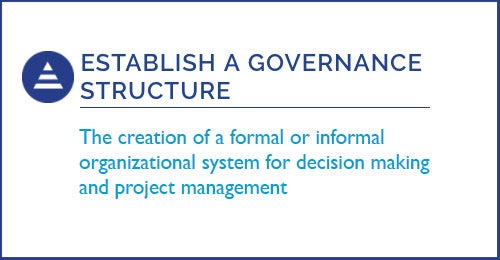Mar 23 2017 Diving Into The Intersector Toolkit: Establish a Governance Structure
 We recently updated our Toolkit for Intersector Collaboration to provide even more useful advice to practitioners involved in cross-sector collaborations. Each week we’ll be profiling one of our 17 tools, with a focus on resources that can help collaborations succeed.
We recently updated our Toolkit for Intersector Collaboration to provide even more useful advice to practitioners involved in cross-sector collaborations. Each week we’ll be profiling one of our 17 tools, with a focus on resources that can help collaborations succeed.
Cross-sector partners may come to a collaboration accustomed to differing methods and models for project management and decision making, models that vary in formality, mechanisms for checks and balances, and hierarchy. But partners aiming to forge successful cross-sector collaborations will need to reconcile their varying expectations to agree upon a structure that is well-suited to the collaboration’s aims and in which all partners are likely to have confidence throughout the collaboration. These formal or informal structures for project management and decision making can take the form of steering committees, workgroups, or facilitated discussions. Governance structures provide direction and promote equity among partners by creating mechanisms to resolve experienced or perceived power imbalances that can arise during collaboration.
How can partners determine what type of governance structure is the best fit for their collaboration? Section 1: Organizational Structure: An Overview of the Community Tool Box’s chapter “Developing an Organizational Structure for the Initiative” provides insights into the common forms that governance structures can take, from steering committees to task forces. The section details what an organizational structure is, and why and when partners should develop one, discussing key elements of a governance structure, partners’ roles within it, and more. This resource contains discussion, a checklist, examples, and a PowerPoint summarizing the major points. (Other sections in this chapter may also be useful for more detailed guidance on particular types of governance structures.)
Once partners have decided on a governance structure, they must consider how to formalize it. Tool 3: Sample Partnering Agreement in The Partnering Initiative’s “The Partnering Toolbook” (found on p. 45) provides a simple one-page template for initial partnering agreements developed between cross-sector partners. Partnering agreements often include details on how the collaboration will be governed and decisions will be made. This particular template also provides for the discussion of committed resources, timing of reviews, and any necessary caveats. Partners can also revisit their Partnering Agreement if they decide to redefine roles and responsibilities when presented with new collaborative tasks.
Partners seeking additional examples of how to formalize governance structures can see StriveTogether’s “Building an Accountability Structure” (found on pp. 23-26), which discusses partnership agreements, MOUs, and bylaws. This resource explores accountability structures among individual members, groups, and partner organizations. It also lists and defines elements of partnership agreements, such as parties involved, objectives, signatures, and more.
See Establish a Governance Structure in our Toolkit for further discussion on this topic, questions to guide tool use, and more.
Explore the full Toolkit and each of the 17 tools with enhanced discussion, questions to guide tool use, and additional resources here.
